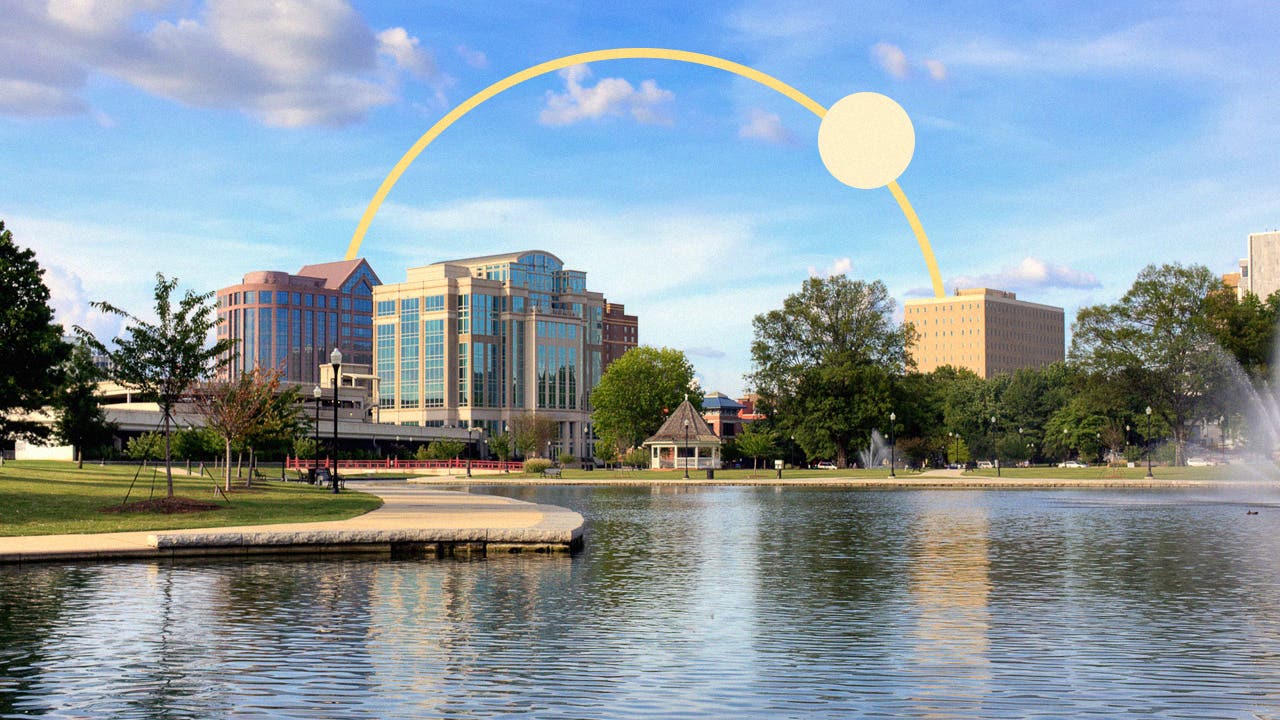
The Bankrate promise
At Bankrate we strive to help you make smarter financial decisions. While we adhere to strict , this post may contain references to products from our partners. Here's an explanation for .
Omaha, Huntsville, Champaign, Des Moines, Green Bay.
These cities and towns may not be top of mind when deciding where to move to next, but they should be. They offer good-paying jobs, growing cultural scenes and not to mention, affordable real estate prices — making them the perfect hidden gems to put down roots if you’re in the market for a house.
Bankrate’s list of hidden gems in America comes at a time when affordability has become a much bigger hurdle for would-be homeowners. Housing prices are still high and mortgage rates are above 6 percent. To cope, the majority of Americans are willing to make sacrifices to find affordable housing, with a quarter of Americans (24 percent) saying they’re willing to move out of their state, according to an April Bankrate housing survey.
While prices went up everywhere during the pandemic-fueled housing boom, the most expensive coastal markets remained far more expensive than markets in the Midwest and Southeast.— Jeff Ostrowski, Bankrate housing market analyst
Key takeaways
- Homes in the Midwest and South are becoming more desirable due to affordability and strong job markets.
- Affordability issues such as high home prices, income that is too low or not being able to afford the down payment and closing costs are holding back nearly 3 in 4 (73 percent) aspiring homeowners, according to an April Bankrate survey.
- A recent Bankrate survey found about a quarter of Americans (24 percent) are willing to leave their state for more affordable housing.
Top 10 hidden gems in America: Metros offering ample job opportunities, affordable homes and growing cultural scenes
To find these hidden gems, Bankrate analyzed the top 150 metro areas with populations less than 1 million across four broad categories: housing prices in relation to local wages, the tightness of the local housing market, the employment picture and wellness and culture. Based on that scoring, these are top 10 hidden gems in America:

1. Omaha-Council Bluffs, NE-IA
- Median home price: $190,000
- Cost of living: 93.2*
- Household median income: $73,720
- Unemployment rate: 2.2%
- Total employees year-over-year: +1.7%
- Well-being: 66.2 out of 100
- Diversity: 47.7 out of 100
2. Huntsville, AL
- Median home price: $325,000
- Cost of living: 89.6*
- Household median income: $76,963
- Unemployment rate: 1.6%
- Total employees year-over-year: +4%
- Well-being: 65.9 out of 100
- Diversity: 53.5 out of 100
3. Des Moines-West Des Moines, IA
- Median home price: $227,375
- Cost of living: 90.2*
- Household median income: $74,208
- Unemployment rate: 2.9%
- Total employees year-over-year: +2.1%
- Well-being: 66.3 out of 100
- Diversity: 40.7 out of 100
4. Green Bay, WI
- Median home price: $230,000
- Cost of living: 90.3*
- Household median income: $66,652
- Unemployment rate: 2.2%
- Total employees year-over-year: +2.6%
- Well-being: 66.2 out of 100
- Diversity: 38.8 out of 100
5. Champaign-Urbana, IL
- Median home price: $179,250
- Cost of living: 86.4*
- Household median income: $59,189
- Unemployment rate: 3.6%
- Total employees year-over-year: +3.4%
- Well-being: 65.2 out of 100
- Diversity: 57.2 out of 100
6. Wichita, KS
- Median home price: $210,000
- Cost of living: 88.5*
- Household median income: $61,131
- Unemployment rate: 3.3%
- Total employees year-over-year: +3.1%
- Well-being: 65.6 out of 100
- Diversity: 51.7 out of 100
7. Amarillo, TX
- Median home price: $239,900
- Cost of living: 82.3*
- Household median income: $58,354
- Unemployment rate: 3.1%
- Total employees year-over-year: +2.8%
- Well-being: 64.6 out of 100
- Diversity: 57.6 out of 100
8. Roanoke, VA
- Median home price: $194,950
- Cost of living: 90.4*
- Household median income: $59,630
- Unemployment rate: 2.8%
- Total employees year-over-year: +3.3%
- Well-being: 65.9 out of 100
- Diversity: 42.6 out of 100
9. Lexington-Fayette, KY
- Median home price: $254,424
- Cost of living: 92*
- Household median income: $62,612
- Unemployment rate: 3%
- Total employees year-over-year: +3.5%
- Well-being: 64.7 out of 100
- Diversity: 46.1 out of 100
10. Fayetteville-Springdale-Rogers, AR
- Median home price: $364,133
- Cost of living: 90.8*
- Household median income: $55,027
- Unemployment rate: 2%
- Total employees year-over-year: +5.1%
- Well-being: 65.4 out of 100
- Diversity: 54.9 out of 100
Note: For the cost of living index, the national average is 100.
Affordability is drawing homebuyers to smaller cities in the Midwest and South
Omaha may have taken the top spot, but several smaller Midwestern and Southern cities rounded out the list. Many Americans are flocking to these regions in droves, and experts chalk it up to housing affordability. Smaller cities, particularly in the Sun Belt and Midwest, can offer a lower cost of living and a better quality of life — particularly at a time when homeownership is moving farther out of reach for many Americans due to elevated home values and high mortgage rates. According to Ostrowski, the average monthly mortgage payment for someone who bought a house in March 2023 is 35 percent higher than for someone who bought in March 2022.
“The Midwest has really been home to the most resilient, steadiest and most consistent housing markets in the nation,” Zillow home trends expert Amanda Pendleton said, citing recent data that shows the Midwest leads the nation in terms of home value appreciation. “As the housing market has slowed down, these markets in the Midwest have been appreciating, and they’re outperforming superstar cities like San Francisco and Seattle. It really comes down to affordability.”
Pendleton said the COVID-19 pandemic accelerated a trend that we were already seeing leading up to 2020: migration from expensive coastal metro areas to the more affordable cities in the Sun Belt. Census data from 2022 shows nine of the nation’s 15 fastest-growing cities were in the South. The reason why: Homebuyers can simply get more home for their dollar in the South, and they’re able to attain homeownership faster.
“You have more affordable mortgage costs, and it’s easier to qualify for a loan because it’s a smaller loan,” Pendleton said. “Another key factor with these metros is that rent is more affordable than elsewhere in the country, so it really shortens that time it takes to save for a down payment. I think that makes these more affordable areas even more desirable.”
How to buy a home in a tough housing market
The combination of high mortgage rates and soaring home prices has left many prospective homebuyers wondering what steps they can take to make their homeownership dreams a reality.
Before starting your search, experts recommend having a solid understanding of your finances and why you want to buy a house, particularly when there are growing concerns about the economy. Consider things like when you intend on moving, what you want in a home and your overall housing budget — including how long it could take you to save for a down payment and how much your all-in costs will be.
When you’re ready, finding an affordable house in a town or city you like is not the only piece of the puzzle. You’ll also likely need a mortgage, or a 15- to 30-year loan to purchase the house now and pay for it over time. Start by getting preapproved for a mortgage, then find a house that you want to put in an offer for, with your preapproval in-hand. Once your offer is accepted, work with your lender of choice to get a mortgage with an interest rate and monthly payment you can afford.
“People have been seeking out lesser-known cities that offer affordability, warmer weather and all the amenities of big city life,” Pendleton said. “When talking about places like Huntsville and Amarillo, they may not be hidden gems for long.”
-
Bankrate’s list of hidden gems in America was compiled using data from a variety of sources, including the U.S. Census Bureau, the U.S. Labor Department and the U.S. Bureau of Economic Analysis. Here is a breakdown of each category:
- Affordability: Bankrate calculated the typical income needed to qualify for a mortgage in each metro area, based on each area’s median home price for January 2023 as reported by Redfin Data Center, with a 10 percent down payment, a 6 percent mortgage rate on a 30-year loan and a mortgage debt-to-income ratio of 25 percent. We compared that number to the Census Bureau’s 2021 estimate of median income for households in each metro area and factored in each metro’s Cost of Living Index, as reported by the Council for Community and Economic Research, from Q2 2022. The index measures the overall cost of living in an area, with a score of 100 representing the national average. This category was given an overall weight of 35 percent.
- Job market: Bankrate ranked each metro area based on its unemployment rate as reported by the U.S. Labor Department in March 2023. Also from the U.S. Labor Department, we looked at total employees year-over-year, which shows the percentage change of employed area residents from March 2022 to March 2023. This category also factored in each metro area’s average commute time, per 2021 Census data. This category was given an overall weight of 30 percent.
- Wellness and culture: Bankrate used Sharecare’s Community Well-Being Index for 2020-2021. The report ranks metro areas on access to healthcare, food and community services, including libraries and houses of worship. We also used the U.S. Census Bureau’s 2020 Diversity Index to measure racial diversity and representation. Lastly, the culture ranking is also based on the number of arts, entertainment and recreation establishments per capita, based on Bankrate’s analysis of 2021 Census data. This category was given an overall weight of 25 percent.
- Housing market tightness: Bankrate used Realtor.com’s median days on the market statistic for homes for sale in April 2023 and the year-over-year change in housing inventory through April 2023. This category was given an overall weight of 10 percent.
Related Articles



10 best U.S. cities to start a career — and most are in the South
